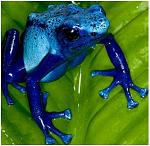Are poisonous to touch

from
here
Spoiler:
Poison frogs are tiny, terrestrial, diurnal frogs that live primarily in leaf litter on the forest floor, but some species live high in the forest canopy and may never come down. All are native to warm Central and South American rain forests near streams or ponds. The frogs’ poison is found in their skin, making them too toxic to touch.
The poisons in these tiny frogs come from their diet in the wild: mostly ants, termites, centipedes, and tiny beetles. This diversity of food items is required to create the chemical toxins by the frog. Specific toxins are passed from each bug to the frog when eaten, which then collect in glands in the frog’s skin. Frogs hatched at zoos aren’t poisonous, because they don’t eat the same food as their wild counterparts. Poison frogs brought from the wild into zoos and fed a regular zoo diet eventually lose most, if not all, of their toxicity.
At the San Diego Zoo and San Diego Zoo Safari Park, poison frogs are fed pinhead crickets, fruit flies, and young springtails.
Each poison frog species produces a different kind of toxin made up of different alkaloids and other chemicals. Scientists have been investigating medical uses for frog poisons and have discovered that some of these alkaloids may be beneficial for people with certain heart and circulatory conditions. One laboratory has developed a new painkiller from the substances produced by the phantasmal poison frog Epipedrobates tricolor. Named “epibatidine” in honor of the frog, it is 200 times more effective than morphine, without all of the bad side effects! Poison frog secretions also show promise for the development of muscle relaxants and heart stimulants.
hallucinogenic